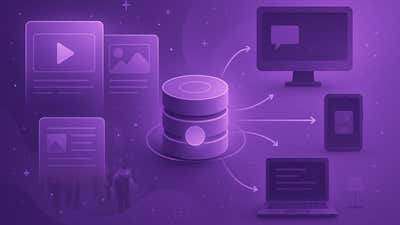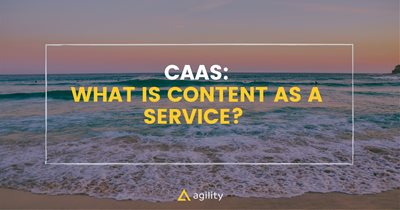What is Content-as-a-Service in 2025-2026?
Highlighting the evolution of CaaS and what's to come


Content-as-a-Service (CaaS) has evolved from a niche concept into the foundation of modern digital experiences. It’s transformed from a developer experiment to a strategic necessity. And it is still reshaping how content is created, distributed, and optimized.
Way back in 2020, Agility CMS President and Co-Founder Jon Voigt wrote a blog titled What is Content as a Service (CaaS)? Here’s how he defined it:
…a new approach to a content presentation that collects all of a company’s content assets in a cloud-based server and intelligently presents it to readers upon request.
That was then. This is now. Let’s examine what has changed and what has stayed the same for CaaS since 2020.
Content-as-a-Service (CaaS): Explained for 2025-2026
Software-as-a-Service (SaaS) delivers ready-to-use software to you via the Internet.
Using that logic, CaaS delivers content via application programming interfaces (APIs) so it can be used across any app, website, channel, or device. The content is created once, stored in a single location – like a headless CMS – and sent wherever it’s needed, whenever it’s needed, through APIs.
The opposite of CaaS would be a traditional CMS platform that locks content inside a channel.
You’d have a specific set of content for a website, another for your app, another for digital signage, and yet another for an IoT device. Even if the content is exactly the same, you still need multiple versions of it.
Think of your favourite movie and all the places you can watch it. For example:
- Theatre.
- TV.
- Smartphone.
- Laptop.
- Tablet.
With a non-CaaS model, the director would need to shoot a completely new version of the movie for each device. That’s impossible, inefficient, and impractical. With CaaS, it’s filmed once, stored centrally, distributed everywhere, and adapts perfectly for every screen.
Apply the same principle to your content. Create it once, store it centrally in a single omnichannel content hub, and deliver it everywhere it’s needed.
What’s Changed with CaaS From 2020 to 2025-2026?
When Jon first published his blog back in 2020, content-as-a-service was still a relatively new idea. Half a decade later, the landscape has shifted. Here’s what’s different now:
|
Aspect |
2020 |
2025-2026 |
|
Adoption |
Early adopters and niche cases. Many businesses were still tied to traditional CMS platforms. |
CaaS is mainstream and rooted in MACH (Microservices, API-First, Cloud-Native, Headless) architectures. It’s not experimental, but table stakes. |
|
Ecosystems |
APIs varied across platforms. Integrations and developer tooling were somewhat limited. |
GraphQL support and SDKs are common. CaaS is a critical element within digital experience platforms (DXPs). |
|
Channels |
Primary focus on websites and mobile apps. The concept of omnichannel content delivery was not fully realized. |
Content now includes AR/VR, wearables, kiosks, display screens, and more. CaaS supports efficient content delivery across so many touchpoints. |
|
AI and Personalization |
Artificial intelligence (if you could call it that) was light and limited to things like tagging. Personalization was rule-based. |
AI is the #1 CMS feature request for 44% of businesses. AI supports personalization with things like content creation, translation, and optimization. |
|
Governance |
Minimal workflows and limited compliance features. |
Role-based access, audit trails, and greater focus on compliance regulations (GDPR, etc.). CaaS platforms can manage essential, regulatory content at scale. |
In five short years, Content-as-a-Service has gone from being an aspirational buzzword to the backbone of digital experience strategies:
- Speedy omnichannel content delivery? Check.
- AI-driven personalization? Check.
- Robust governance and compliance? Check.
CaaS is no longer a developer experiment or marketer wish. It’s the nucleus of modern content infrastructure as it powers personalized, omnichannel experiences at scale.
How a Headless CMS Supports Content-as-a-Service
In many ways, the headless CMS platform advantage is what makes CaaS possible.
1. Decoupling Content from Presentation: Create Once, Deliver Everywhere
Traditional CMS platforms tightly bind content creation and presentation to a single channel. It may work well for a single website template, but repurposing for other channels is hard. A headless CMS like Agility CMS breaks this link by decoupling the backend (where the content lives) from the front end (how it looks).
Since a headless CMS delivers content as structured data, it can be reused across any channel or device. A single piece of content – like a product description or a blog post – can appear on a website, mobile app, or digital screen without duplication or extra effort.
Content is stored in a central location and accessed through APIs. This ensures that it’s displayed properly wherever it appears: websites, apps, kiosks, digital signage, etc.
2. Omnichannel Support
Beyond content distribution, a headless CMS structures content in a way that makes it reusable and scalable.
Content components are structured in fields so they can adapt automatically to any front-end context. Wherever CaaS pushes that content to – a website, app, wearable, etc. – the Title Field will always render as a title, and the Image Field will always appear properly. This ensures a seamless, consistent experience for everyone who interacts with your content.
Why CaaS Matters More Than Ever in 2025-2026
In 2016, mobile traffic surpassed desktop traffic. Today, roughly 64% of global web traffic is mobile, and 36% is desktop. That forced businesses and marketers to think “mobile-first” when creating and distributing content.
Furthermore, the average business uses 10 channels to connect with – and ultimately sell to – customers. That means content teams are producing more content across more channels than ever before. That content must be relevant, personalized, and accessible on websites, mobile apps, kiosks, IoT devices, and more.
Creating content is (relatively) straightforward. Getting it to all those channels with speed and scalability? That’s the tricky part.
Looking Into the Future: CaaS in 2030 and Beyond
In the CaaS framework, after you update your central piece of content (a blog post, product description etc.), APIs get to work fetching and delivering the updated content to all your channels.
In 2025, there’s still the human element of going in, making the change, and pushing it live. Someone still has to do it. For now.
In 2030 (or even sooner), content may be generated, personalized, and distributed automatically by AI. These autonomous decisions could be driven by real-time data and user behaviour.
Here’s a hypothetical example:
- Scenario: A particular t-shirt sold by a global eCommerce retailer goes viral on TikTok, sending a surge of traffic to the company’s site.
- AI CaaS in Action: The system detects this spike and automatically generates new copy and visuals to promote the trending product. Without any human input, AI and CaaS update every digital touchpoint (website, app, in-store kiosk, display screens) to highlight the t-shirt.
- Additional Actions: The system may also adjust product recommendations on other pages to showcase the t-shirt. It can also launch an email campaign and post on social media. All using the content the system generated based on data, behaviour, and predictive insights.
In this (imagined) future, CaaS morphs from being a delivery mechanism to becoming the AI-powered core of your digital ecosystem. It doesn’t just serve content where it’s told to, it actively decides what to deliver, how to present it, and when to update it.
- What Does It Mean? Content is no longer static or reactive. Content becomes a living, adaptive part of the digital experience. It continuously evolves to meet your audience wherever they are.
CaaS is the Present – and Future – of Content
Content-as-a-Service has come a long way in a short time. It was an emerging architectural concept in 2020, and now it’s the pillar of the digital experience. As we move forward, CaaS may evolve from simply delivering content to actively generating and delivering it in real time.
But that content needs a central location. If you think of the hub-and-spoke model, the hub is where the content comes from, and the spokes are where it goes.
Agility CMS is that hub.
It’s a flexible, scalable platform designed to power a true CaaS approach. It gives you one place to create and manage content, along with the freedom to deliver it anywhere your audience is today – or will be tomorrow.
Ready to Build a Future-Proof Content Strategy?
- Get a Demo to see how Agility CMS powers CaaS across every channel.
- Start a FREE Trial and experience how easy it is to create, manage, and deliver content at scale.

About the Author
Mauro Flammini is the Content Manager at Agility CMS. He has over 20 years of content marketing experience, including for international brands such as Research In Motion and Intuit. He lives in Hamilton, ON with his wife, two daughters, and one dog.
View Related Resources

What is Content as a Service? (CaaS)

How to Structure Modular Content for Maximum Reusability: The Ultimate Guide

